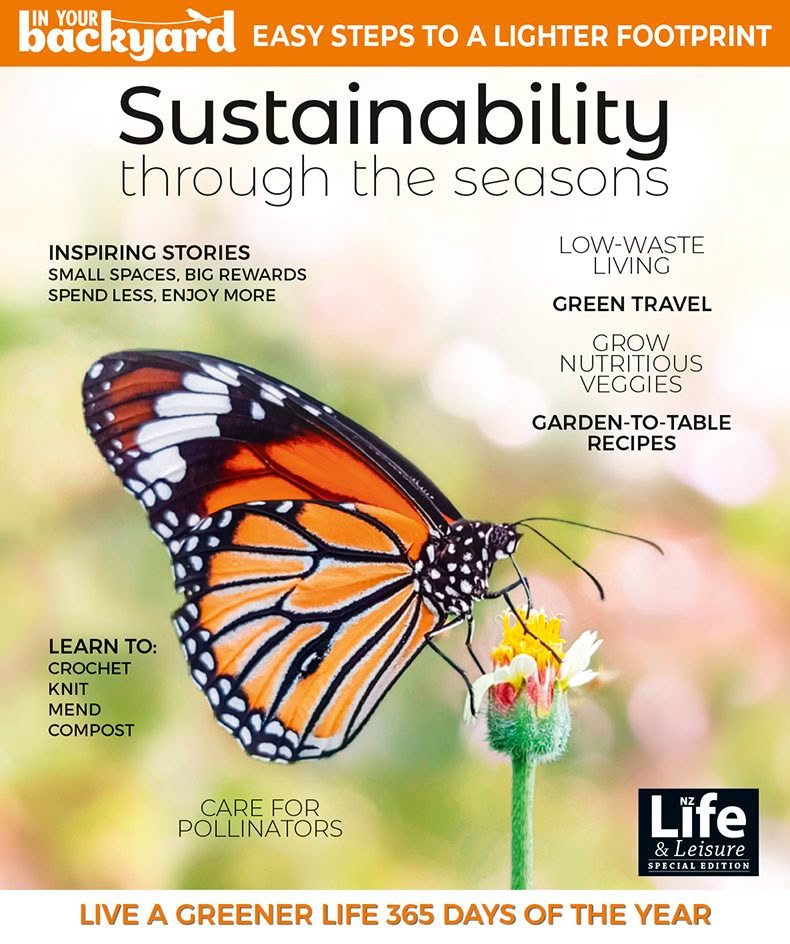Slow fashion 101: A New Zealand guide to sustainable fashion and what to buy and what fabrics are best

New Zealand brand Kowtow uses only renewable and sustainable fibres.
Clothing has an enormous impact on the environment and, very often, an effect on the people who make it. When purchasing, remember these Rs ‒ reduce, recycle, resale, repair, repurpose and even rent.
Words: Lee-Anne Duncan
As if getting dressed isn’t fraught enough; these days the question is less “what to wear” and more “what are these clothes made from, by whom, and how is the planet impacted?”
Humans cannot live without clothes as they’re needed for warmth and protection as well as being an expression of personality and taste. Fashion is big business and understanding how the fashion industry impacts the planet helps consumers make informed choices.
Fashion’s contribution and cost
The fashion and textile industry employs approximately 300 million people worldwide, often in countries with few opportunities for high-wage employment. In New Zealand, the fashion retail industry alone employs close to 15,000 across 2120 businesses. According to the website, fashionunited.nz, New Zealanders spend four per cent of their income on clothes and shoes equally – some $5.4 billion a year.
Worldwide, the fashion and textile industry generates US$3 trillion dollars in revenue, making a valuable contribution to national and household economies. However, it also inflicts a substantial environmental cost, both in terms of resources and contribution to greenhouse gases.
Cotton is the world’s most commonly used textile. It’s a natural product often thought of as an excellent environmental choice. But, no – cotton is incredibly thirsty. A single tee-shirt takes 2720 litres of water to make (the equivalent of three years of drinking water for the average person), and about 10,000 litres of water are used up manufacturing a single pair of jeans. The United Nations estimates cotton drinks up three per cent of global water use.
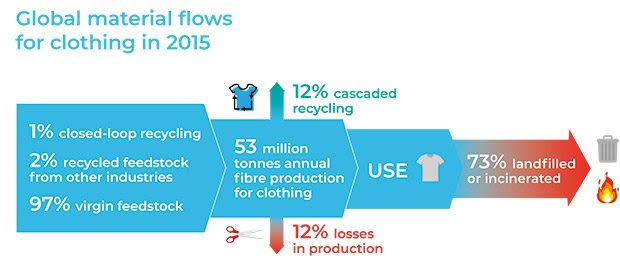
Farming cotton also requires the heavy use of pesticides, which degrades the soil and affects insect life. Then there are the human costs; the people working in the fields and factories – very likely for low pay – suffer the health impacts of toxic dyes and of breathing in fabric fibres.
Synthetic fabrics are generally made from non-renewable petrochemicals, so are undesirable from the get-go. Then they have literal downstream effects as microfibres from the materials pollute oceans, affecting wildlife and food sources.
A single clothes wash can release about 700,000 plastic particles from the synthetic fibres. Polyester is the worst offender. The fashion and textile industry also contributes an estimated 1.2 billion tonnes of greenhouse gases a year – more than international flights and maritime shipping combined. Those emissions are created during production and when the garments are discarded to the the landfill, which is where the vast majority of clothing ends up.
Each kilogramme of fabric sent to the the landfill is associated with more than 2kg of greenhouse emissions, says Bernadette Casey, creative director at The Formary, a Wellington-based company addressing climate change by building the systems and technology to extract greater value from clothing.
“Specifically, those gases include methane, which has 72 times the warming potential of carbon dioxide. Textiles are the fastest-growing waste stream in many areas around New Zealand. The Auckland Council conservatively estimates textile waste at nine per cent of landfill, and it’s growing,” she says.
Combine the after-use environmental costs with those accumulated during a garment’s production and it is clear: the price of fashion is far more than the figure on the swing tag.
LOWER PRICE, HIGHER COST
The world is producing more and more clothes. This is particularly so over the past 15 years, and is driven by consumer demand for “fast-fashion”. “We have an over-consumption problem, but it starts with an overproduction problem,” says Bernadette.
Fast-fashion stores refresh their lines every few weeks, enticing consumers with the latest “must-haves” of the season. The result is at least 100 billion new garments each year. And if a purchase is made, those cheaply made garments will very likely be worn only a handful of times.
“The average Zara garment is worn just six times. Fast-fashion is not built to last – it’s meant to be bought, worn and discarded,” says Bernadette.

Bernadette Casey, creative director at The Formary.
But popping it in a charity clothing bin isn’t the answer. That accompanying glow of giving to charity is misplaced. The charity receives only a fraction of the profit, says Bernadette, while the rag-making companies bank the rest. What can’t be on-sold domestically is chucked into the landfill anyway, or shipped overseas.
“About 70 per cent of our donated waste clothing is sold offshore to developing countries, which has a massive impact on their local textile industries. It’s creating significant social impacts through the closure of local industries and the loss of skilled jobs.
“The Ellen MacArthur Foundation [a British not-for-profit) warns that the consequences of not addressing clothing waste as a global problem could now be ‘potentially catastrophic’. And a recent report from the Intergovernmental Panel on Climate Change gives us just 12 years to limit a climate-change catastrophe. This is something we need to move on now,” says Bernadette.
HIGH-TECH SOLUTIONS
Just one per cent of the 100 billion garments produced each year are destined to be recycled. However, many companies around the world – including The Formary – are focused on finding new ways to use old clothes. Among its many workstreams is a still-in-development application that allows companies to understand the environmental impact of commissioning new uniforms and offers help in making the most environmentally beneficial choices.
The Formary also works with companies to decommission uniforms in an environmentally friendly way, reworking their old uniforms into new fabrics.

Adrien Taylor’s Wellington company, Offcut Caps, makes hats from fabric remnants.
“We are disrupting the failing linear pattern of textile use – namely, manufacture, purchase, wear, then the landfill,” says Bernadette. “The post-consumption space is transforming quickly, as we now have technologies, such as blockchain, that allow us to track material flows and impacts.”
Spectroscopy is another technology that helps scan and identify textiles to allow commercial-scale sorting of garments, and fibre-to-fibre technology converts post-consumer textiles into raw chemicals. “Some synthetic fabrics can also now be chemically recycled again and again without losing quality.”
These developments loop waste textile resources back into production, reducing the use of virgin materials and cutting greenhouse gas emissions from the landfilled fabrics. But the best answer is always to buy fewer clothes and wear them for longer.
FABRIC PROS AND CONS
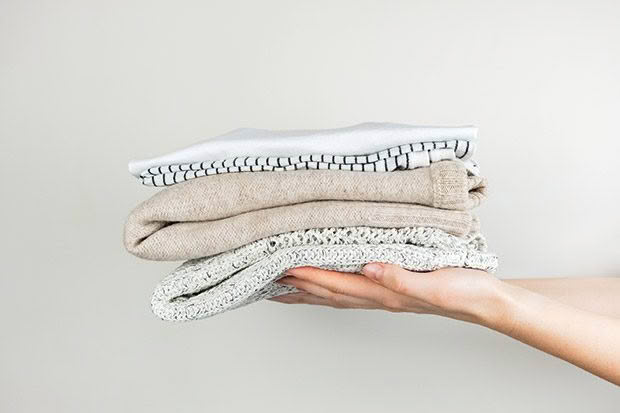
Consumers play the most vital part in slowing down fashion and its impact on the Earth. “We need to change how we view fashion; we should buy garments we love and wear them for as long as possible,” says The Formary’s Bernadette Casey, whose wardrobe is full of old favourites. “We should wear a piece of clothing for special occasions, then for work, then at home. Then mend it and wear it in the garden.”
When buying, check the label for more than price, she says. The type of fabric clothes are made from must be declared. Ensuring it is sustainable is one of the best ways of constructing an eco-friendly wardrobe. Here are some ideas about what fabrics to look for – and those to avoid. Generally, choose natural and organic fibres, as these are made from plants and few pesticides are used. They are also biodegradable and don’t shed microfibres.
Recycled & organic cotton
Nearly a quarter of all clothes, and half of all textiles, are made from cotton as it’s light, breathable, durable and easy to use and care for. But one cotton can be better than another cotton. Organic cotton, while still water-dependent, is usually rotation-grown to minimize chemical use. Organic cotton should be GOTS-certified to ensure high standards in production. (GOST stands for Global Organic Textile Standard.)
Even better, choose recycled or upcycled cotton garments. These might be made from cotton waste, either from factory off-cuts and remnants or post-use recycled cotton fabric. That has the added bonus of keeping cotton out of the landfill. (But at least cotton is biodegradable.)
Organic hemp
Hemp is so very “now” and probably not before time. It’s versatile and great when manufactured into a fabric, something that’s been done for hundreds of years – it’s one of the world’s oldest fibres. Hemp can grow in many climates and environs, requires little water, no pesticides and is kind on the soil, naturally fertilizing it as it grows. As a fabric, it’s warming in winter and cooling in summer. It also gets softer with washing. Hemp is an excellent sustainable choice.
Wool
Wool is tough, doesn’t wrinkle, is warm, durable and biodegradable. It’s also easy to dye, so natural dyes work well, making chemical dyes less necessary. It’s excellent for outdoor wear and doesn’t shed micro-fibres which pollute waterways and affect wildlife.
However, it’s an animal product, and farming practices vary from country to country. Most wool comes from sheep, a ruminant animal, and there is the issue of methane emissions. An estimated 50 per cent of wool’s carbon footprint is attributed to the sheep themselves, rather than the manufacturing processes – spinning and dyeing the yarn, and creating the garments. In New Zealand, sheep are more often farmed on less-viable land than dairy.
A word about cashmere; as it becomes more affordable, concerns are rising about animal welfare, herders’ working conditions, and environmental damage from increased goat numbers. Check the brand’s ethical rating.
Organic linen
Similar to hemp and wool, linen has been used in textiles for centuries. Again like hemp, it comes from a simple but very versatile plant – flax. It needs few pesticides and little water and can grow in poor quality soils. Linen is durable, resists moths, and is usually biodegradable (depending on the dyes used). It’s light to wear, great for warm temperatures and doesn’t smell.
Tencel
Tencel is a light “cellulose fabric” made by dissolving wood pulp, often eucalyptus. It’s said to be more absorbent than cotton. It is moisture-wicking and anti-bacterial and needs less energy and water to produce. The chemicals used to dissolve the wood pulp are managed in a closed-loop system so aren’t disgorged into waterways. Check that the wood has been sustainably grown and harvested.
Rayon and modal
These are man-made from cellulose. Cellulose comes from softwood trees, and viscose rayon is usually from bamboo – an increasingly common textile source. It’s useful that it’s from a natural-source material, but the chemicals (such as carbon disulphide) required to make it can be toxic to the factory workers, linked to Parkinson’s disease, heart attack and strokes.
There’s also the issue that some producers are clearing rainforests to plant bamboo for textile manufacturing. It can be processed mechanically, rather than chemically, into “bamboo linen” but it’s hard to find and comparatively more expensive.
Silk
Silk is a natural protein fibre produced by several insects; most notably, it’s manufactured from the mulberry silkworm. Silk is spun from the long threads which make up the cocoon of a silkworm. Silk is durable, and the process of harvesting is reasonably environmentally friendly because the mulberry tree is not reliant on pesticides or fertilizers. The silk-making process kills the worm larvae as the cocoons are boiled. Ahimsa silk (sometimes called peace silk) allows the larvae to hatch from the cocoon before it is boiled.
High-tech fabrics
Several high-tech fabrics may also be a decent choice. However, most are not yet easy to find or afford.
Piñatex
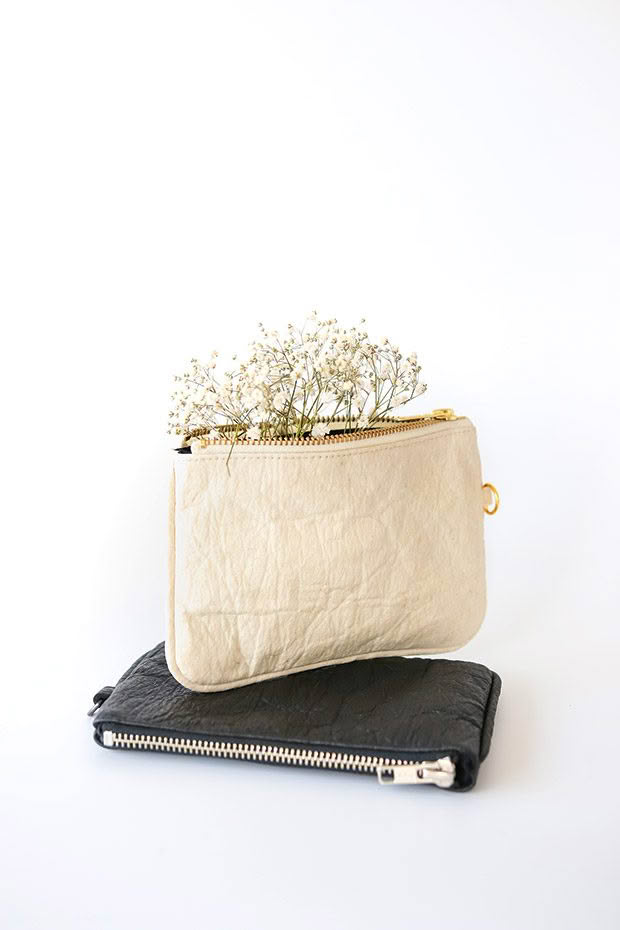
Pineapple leather (Piñatex) bag by New Zealand label Velvet Heartbeat.
A vegan leather alternative, Piñatex is made from pineapple-leaf fibre, so it’s cruelty-free, natural and sustainable. It’s also made from a food byproduct, so reduces waste, and gives farmers another income stream.
Econyl
This nylon-like fibre, made in Italy, is 100-per-cent-made from recycled synthetic waste, such as industrial plastic, waste fabric, old carpets, and discarded fishing nets, into new material. The collected waste is cleaned and shredded, put through a depolymerizing process to extract nylon, re-polymerized and made into yarn, which is then woven into textile products.
The process uses a closed-loop system (so all waste is managed or reused), less water, and creates less waste than usual nylon production. It’s not perfect as it does shed plastic micro-particles, so it is recommended for garments that don’t require much washing, such as footwear or bags.
Qmonos
This is a “bio-fibre protein material”, also known as a synthetic spider silk. Invented in Japan, it’s created by inserting designed spider DNA into bio-engineered bacteria, which is fed with sugar. Silk proteins are then extracted from the bacteria and refined into thread.
Meaning “spider web” in Japanese, Qmonos is said to be five times stronger than steel, lightweight, flexible, and biodegradable. Because no spiders are harmed, it’s an alternative to traditional silk, although at the moment it’s hard to find and expensive. A North Face jacket made of Qmonos costs more than $1000.
WHAT TO AVOID
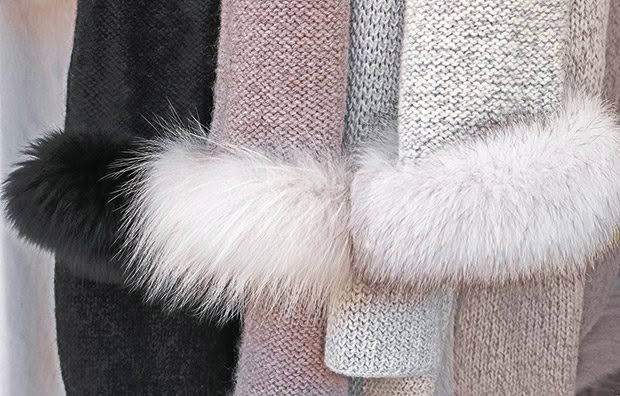
Avoid faux fur, which releases microfibres.
Conventional cotton: Uses too much water, too many pesticides and other unsustainable farming practices that damage the soil, waterways and wildlife. Widespread poor labour practices also affect workers.
Polyester and nylon: Both are made from plastic and fossil fuels, and manufactured using a polluting production system. Buying second-hand or recycled polyester is slightly better but there’s still the issue of plastic microfibres entering waterways.
Coloured faux fur: This is made from synthetic fibres, coloured with synthetic dyes, which shed toxins and microfibres when washed.
WHAT CAN WE DO?
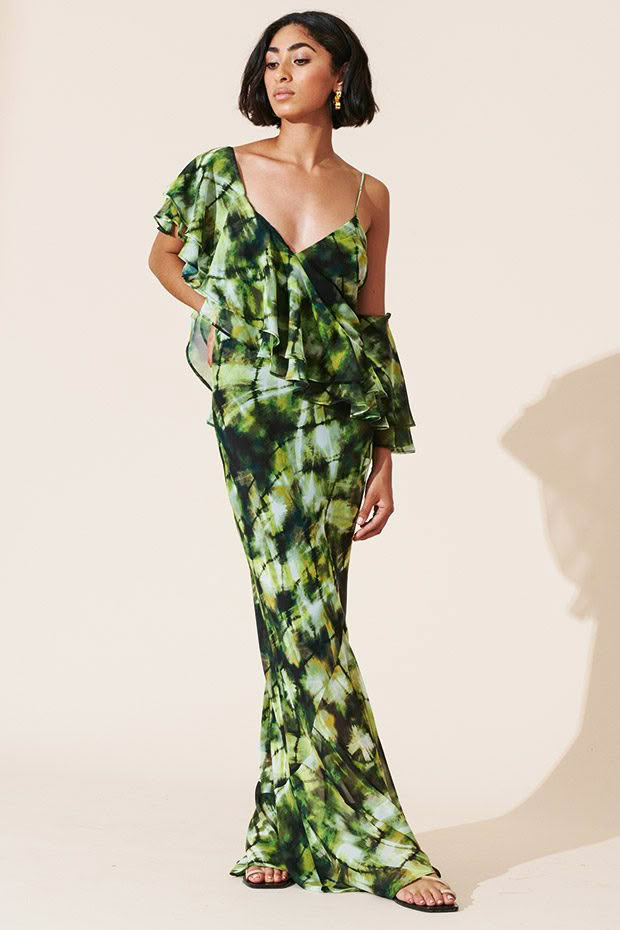
Fashion brand Ruby has a rental range available from Designer Wardrobe.
Consumers play a role in ensuring clothes are sustainably produced. Much comes down to making an ethical purchase — or not purchasing at all.
1. Reduce: Buy less. Full stop. Spend a moment to think before handing over the credit card. Is it indispensable? Have another look in the wardrobe — is there something in there that hasn’t been worn in a while?
2. Recycle and resale: The resale market is massive and has now overtaken luxury in terms of sales. Shop at recycled boutiques, sell what’s no longer sparking joy and buy second-hand and vintage goods that give pleasure without costing the earth.
3. Refuse: Demand clothing suppliers show that their supply chains and production practices are sustainable, and refuse to buy if they’re not. Smartphone apps such as Good on You provide supply-chain data to rate clothing brands on their social, animal and environmental impact.
4. Repair and repurpose: Learn how to replace a zip, re-hem a skirt, fix a rip, or repurpose something old into something new. That could help save the planet — and the cost of buying a replacement. Several organizations run making and mending workshops, so google to see what’s nearby.
5. Rent: Consider renting or leasing clothing. Check out, for example, lendthelabel.co.nz or designerwardrobe.co.nz, which allow renting and reselling. Similar to reselling, renting is a quickly growing market. For example, renttherunway.com in the United States has been valued at US$1 billion.
Read more stories like these in our latest special edition, Sustainability Through the Seasons, a practical guide to living a greener and more environmentally friendly life 365 days of the year.
